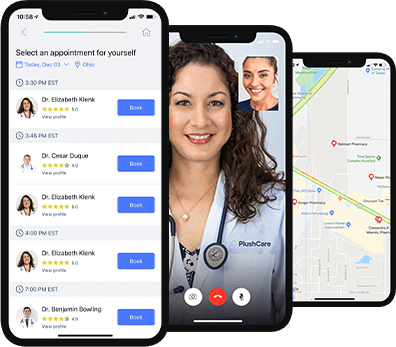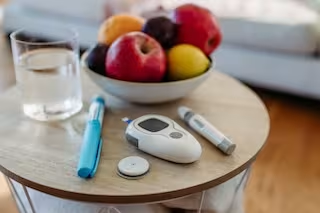What Is Prediabetes?
Approximately 86 million people in the United States have prediabetes, and yet, 22% of them don't even know it. A further 28.9 million people (15.5 million men and 13.4 million women) have type 2 diabetes.
The good news is that you can actually reverse prediabetes before it develops into type 2 diabetes. If you have prediabetes and act now, you can prevent the complete onset of type 2 diabetes. The earlier you act, the greater your chances of a positive outcome can be.

1
Book on our free mobile app or website.
Our doctors operate in all 50 states and same day appointments are available every 15 minutes.
2
See a doctor, get treatment and a prescription at your local pharmacy.
3
Use your health insurance just like you normally would to see your doctor.
What Does Prediabetes Mean?
Prediabetes, or borderline diabetes, is a warning that your blood sugar is higher than it should be, and that you are on a path toward type 2 diabetes unless you make significant lifestyle changes.
Your blood sugar levels may not be quite elevated enough to be diagnosed with type 2 diabetes, but the long-term damage of diabetes may already be starting inside your body. As our nation struggles with an obesity epidemic, more children and teenagers are being diagnosed with prediabetes than ever before.
What used to be referred to as "juvenile diabetes" and "adult-onset diabetes" are now referred to as type 1 and type 2 diabetes to reduce confusion and enforce the notion that even children are susceptible to prediabetes and type 2 diabetes.
Prediabetes is occasionally referred to as impaired glucose tolerance (IGT) or impaired fasting glucose (IFG), depending on the type of prediabetes blood test used to make the diagnosis.
Along with a higher risk of developing diabetes, prediabetes puts you at a greater risk of developing cardiovascular disease.
What is the Difference Between Type 1 and Type 2 Diabetes?
Both types of diabetes are serious, long-term diseases that affect how your body handles blood sugar, also known as glucose.
The two types of diabetes cause different problems regulating glucose. Glucose helps to fuel your body's cells, but it needs the help of insulin, which is produced by the pancreas, to move from the bloodstream into the body's cells.
Read: What's the Difference Between Type 1 and Type 2 Diabetes?
Type 1 Diabetes
Previously referred to as juvenile diabetes because it is commonly diagnosed in childhood and adolescence, Type 1 Diabetes is a condition where a person's body doesn't produce insulin because its immune cells attack insulin-producing cells called beta cells.
Since the body needs insulin to get energy from glucose, people with type 1 diabetes need regular insulin injections to manage glucose levels in their blood and use it for energy.
Type 2 Diabetes
Previously referred to as adult-onset diabetes, Type 2 Diabetes refers to people whose bodies don't respond to insulin the way they should. Eventually, their bodies do not produce enough insulin to manage the glucose levels and rely on pills, injections, or even inhalable insulin to extract energy from glucose.
What Are The Warning Signs Of Prediabetes And What Are Some Prediabetes Symptoms?
Prediabetes may not cause any signs or symptoms at all. As it progresses toward type 2 diabetes, it may start to cause symptoms of diabetes.
Many people live with prediabetes for years without knowing it because they aren't experiencing any symptoms - the only clue lies in their blood.
Those who do experience signs of prediabetes will often notice symptoms such as:
Increased thirst
Feeling hungrier than usual
Increased urination
Unexplained weight loss or gain
More urge to urinate
Fatigue
Signs of Diabetes
Approximately 8 million people in the United States who have type 2 diabetes aren't even aware of it because they aren't experiencing any symptoms yet.
General signs of diabetes include:
Being very thirsty
Being hungrier than usual
Peeing a lot
Breath odor that is fruity, sweet, or like acetone
Nausea
Blurry vision
Unexplained weight loss
Tingling or numbness in your hands or feet
Darkening of skin in areas of body creases (acanthosis nigricans), such as the neck, armpits, groin
Feeling worn out
Wounds that don't heal
Skin infections that keep coming back
Risk Factors For Diabetes
Several factors can increase your odds of developing type 2 diabetes. Men are at increased risk of developing type 2 diabetes compared to women. Other risk factors for diabetes include:
Prediabetes
A sibling or parent with diabetes
Ethnicity: increased risk for Asians, Hispanics, Native American, Alaska Natives, and African Americans
Age
Obesity or being overweight
Depression
Excess fat around the middle (a waist larger than 40" around for men or 35" around for women)
High blood pressure
High levels of triglycerides, a form of cholesterol
Low levels of high-density lipoprotein (HDL) cholesterol
Metabolic syndrome, which is a combination of high blood glucose, extra fat around the waist, high blood pressure, and high cholesterol and triglycerides
Your liver produces too much glucose
Not getting any or enough exercise
Smoking
Excess alcohol intake
Lack of sleep (especially due to sleep apnea or working overnight or irregular shifts)
Having had gestational diabetes, which is diabetes during pregnancy
Giving birth to a baby weighing more than 9 pounds
Polycystic ovary syndrome
Low testosterone in men
Unhealthy diet

1
Book on our free mobile app or website.
Our doctors operate in all 50 states and same day appointments are available every 15 minutes.
2
See a doctor, get treatment and a prescription at your local pharmacy.
3
Use your health insurance just like you normally would to see your doctor.
Diabetes Symptoms In Men
Men display some different signs and symptoms of diabetes than women. These include:
Erectile dysfunction (also referred to as ED, or impotence)
Retrograde ejaculation (when semen reaches the bladder instead of leaving the penis, also called a dry orgasm)
Low testosterone (also referred to as low-T)
Decreased sex drive (libido) and sexual dysfunction
Diabetes Symptoms In Women
Some symptoms affect only women instead of men.
They include:
Vaginal and oral yeast infections, as well as vaginal thrush.
Vaginal symptoms include itching, soreness, discharge, and painful sex.
Oral symptoms include a coating on the tongue and inside of the mouth that resembles cottage cheese.
Urinary Tract Infections (UTI).
Diabetes causes poor circulation and makes it harder for white blood cells to travel through the bloodstream and kill infections. This can lead to bacteria entering the urinary tract, which causes a UTI. Symptoms of a UTI include painful urination, a burning sensation, and bloody or cloudy urine. Untreated UTIs can lead to kidney infections.
Decreased sex drive
Polycystic Ovary Syndrome (PCOS). PCOS is not necessarily a symptom of diabetes, but it does increase a woman's risk of developing diabetes because it can cause elevated blood sugar levels.
Pregnancy And Diabetes
It is possible to have a healthy pregnancy if you have diabetes. Still, it is critically important to manage your blood sugar levels before and during your pregnancy, as high glucose levels can lead to excessive birth weight of the baby resulting birth injuries due to being wedged in the birth canal, early birth, serious breathing difficulties of the baby, stillbirth, and high blood pressure and preeclampsia of the mother which is a serious complication of pregnancy threatening life of mother and baby.
Before trying to get pregnant, you will want to get your blood glucose levels as close to your target range as possible first. Your doctor may suggest a different target range once you become pregnant.
You should talk to your doctor before and during your pregnancy about managing your health during your pregnancy. Your doctor will likely want to track your general health and blood glucose levels before and during your pregnancy.
Long-term Health Complications Of Diabetes
Diabetes causes a wide variety of complications, some of which can be life-threatening. Some of those complications include:
High blood pressure
Heart disease
Stroke
Nerve damage and neuropathy (nerve pain)
Kidney disease
Retinopathy (nerve damage in the eye which may lead to blindness)
Hearing impairment
Foot damage potentially leading to amputations
Skin infections
Peripheral vascular disease
Yeast infections
Higher risk for developing Alzheimer's disease
What Blood Sugar Level Is Prediabetes And How Is It Tested For?
There are several tests that your doctor may choose to run to test for diabetes or prediabetes. Some tests may be run two days in a row to get an even more accurate picture of your blood glucose levels. Some of those tests include:
A1C:
The A1C test measures the average of our blood glucose levels over the last 2-3 months. This test does not require fasting like the fasting plasma glucose (FPG) test or drinking a sweetened liquid and returning for more testing after 2 hours like the oral glucose tolerance test (OGTT).
An average A1C level is less than 5.7%.
A level between 5.7-6.5% is within the prediabetes range.
An A1C level higher than 6.5% indicates diabetes.
Fasting plasma glucose:
The fasting plasma glucose (FPG) test must be done after 8 hours of fasting and is usually performed first thing in the morning. You can't eat or drink anything except water for 8 hours before the test to see what your blood glucose level is without the recent addition of more glucose from food or drink. A normal FPG reading is less than 100 mg/dl. A reading between 100-125 mg/dl indicates prediabetes. A reading of 126 mg/dl or higher indicates diabetes.
Oral glucose tolerance test:
The oral glucose tolerance test (OGTT) tests your blood after 8 hours of fasting. After fasting, you drink a special sweetened liquid and return two hours later so that your doctor can see how well your body is processing glucose. A normal OGTT reading is less than 140 mg/dl. A reading between 140-199 mg/dl indicates prediabetes. A reading that is 200 mg/dl or higher indicates diabetes.
Random or casual plasma glucose test:
You can take a random or casual plasma glucose test any time you are experiencing symptoms of diabetes or during regular checkups. A reading of 200 mg/dl or higher indicates diabetes.
Prediabetes Treatment
Luckily, leading a healthier lifestyle can help reverse prediabetes and prevent the onset of type 2 diabetes. Your doctor will recommend a plan specific to your health and situation, but some general guidelines include:
Improving Your Diet
Talking to a registered dietitian (RD) or a certified diabetes educator (CDE) can help you create a meal plan that considers your overall health, the amount of exercise you get, and what you like to eat. You will also learn what foods to avoid if you have prediabetes.
This meal plan will be designed to be beneficial for both your overall health and your blood glucose level, to keep your glucose levels within normal ranges.
Read More: Type 2 Diabetes Symptoms and Treatments
Exercising More
Exercise can lower your blood glucose level because it causes your body to use glucose to feed your muscles. During exercise, your body also doesn't need as much insulin to use the glucose, which can help your body to become less insulin resistant.
Since one of the problems with prediabetes and diabetes is that it causes insulin resistance, where the cells of your body do not react to insulin and thus cells do not take up glucose from your blood, resulting in elevated blood glucose levels. Reducing that insulin resistance through exercise is a great way to get your health back on track.
According to the American Diabetes Association, you should aim for at least 150 minutes of moderate exercise each week, or 30 minutes five times a week. Moderate exercise includes activities like walking, swimming, or riding a bike.
Losing Weight
Losing even 5-10% of your body weight can significantly reduce your odds of developing type 2 diabetes. For a 200-pound person, that's only 10-20 pounds (although you should eventually aim for a weight that your doctor thinks would be beneficial for your overall health).
The best way to lose weight is to exercise more and eat better. Implementing new healthy habits into your daily routine can help you not only lose weight in the short term but keep it off in the long term.
Taking Metformin
If your doctor decides that you are at high risk of having your prediabetes develop into type 2 diabetes, they may recommend a medication called metformin. It's the only medication that the American Diabetes Association recommends for consideration preventing type 2 diabetes in those who have prediabetes and are at increased risk of developing diabetes with certain conditions.
Metformin prevents your liver from making more glucose when your body doesn't need it, which helps to keep your blood glucose levels in a better range. Your doctor will want to carefully monitor your blood glucose levels to see whether or not they are improving.
They may suggest adding exercise for tweaking your diet to see further improvement in your glucose levels.

1
Book on our free mobile app or website.
Our doctors operate in all 50 states and same day appointments are available every 15 minutes.
2
See a doctor, get treatment and a prescription at your local pharmacy.
3
Use your health insurance just like you normally would to see your doctor.
Get Treated Today
Thanks to the growth of telehealth platforms like PlushCare, accessing healthcare is easier than it's ever been. Receive a prediabetes diagnosis and treatment plan the same day you book thanks to this revolution in telehealth medicine.
Book an appointment with an experienced PlushCare physician today to get the treatment you need to help get your health, and your life, back on the right path.
Sources:
PlushCare is dedicated to providing you with accurate and trustworthy health information.
Mayo Clinic. Type 1 diabetes. Accessed on February 14, 2021 at https://www.mayoclinic.org/diseases-conditions/type-1-diabetes/symptoms-causes/syc-20353011
U.S. National Library of Medicine. Medline Plus. Urinating more at night. Accessed on February 14, 2021 at https://medlineplus.gov/ency/article/003141.htm
American Diabetes Association. Statistics About Diabetes. Accessed on February 14, 2021 at https://diabetes.org/about-diabetes/statistics/about-diabetes
Mayo Clinic. Type 2 Diabetes. Accessed on May 09, 2021 at https://www.mayoclinic.org/diseases-conditions/type-2-diabetes/symptoms-causes/syc-20351193
Mayo Clinic. Acanthosis Nigricans. Accessed on May 09, 2021 at https://www.mayoclinic.org/diseases-conditions/acanthosis-nigricans/symptoms-causes/syc-20368983
Mayo Clinic. Diabetic Ketoacidosis. Accessed on May 09, 2021 at https://www.mayoclinic.org/diseases-conditions/diabetic-ketoacidosis/symptoms-causes/syc-20371551
National Library of Medicine. The Journal of clinical psychiatry. Depression as a risk factor for diabetes: a meta-analysis of longitudinal studies. Accessed on May 09, 2021 at
American Heart Association. Diabetes Risk Factors. Accessed on May 09, 2021 at https://www.heart.org/en/health-topics/diabetes/understand-your-risk-for-diabetes
Cleveland Clinic. Blood Sugar: Hidden Causes of High Blood Sugar Levels in the Morning. Accessed on May 09, 2021 at https://my.clevelandclinic.org/health/articles/11443-blood-sugar-hidden-causes-of-high-blood-sugar-levels-in-the-morning
Centers for Disease Control and Prevention. Smoking and Diabetes. Accessed on May 09, 2021 at https://www.cdc.gov/tobacco/campaign/tips/diseases/diabetes.html
Sleep Foundation. Lack of Sleep and Diabetes. Accessed on May 09, 2021 at https://www.sleepfoundation.org/physical-health/lack-of-sleep-and-diabetes
American Diabetes Association. Relationship Between Testosterone Levels, Insulin Sensitivity, and Mitochondrial Function in Men. Accessed on May 09, 2021 at https://care.diabetesjournals.org/content/28/7/1636
American Diabetes Association. Sex and Diabetes. Accessed on May 09, 2021 at https://www.diabetes.org/diabetes/complications/sex-diabetes
U.S. National Library of Medicine. Urology case reports. Retrograde Ejaculation: A Rare Presenting Symptom of Type 1 Diabetes Mellitus. Accessed on May 09, 2021 at
Centers for Disease Control and Prevention. Diabetes and Women. Accessed on May 09, 2021 at https://www.cdc.gov/diabetes/library/features/diabetes-and-women.html
Cleveland Clinic. Thrush. Accessed on May 09, 2021 at https://my.clevelandclinic.org/health/diseases/10956-thrush
Centers for Disease Control and Prevention. PCOS (Polycystic Ovary Syndrome) and Diabetes. Accessed on May 09, 2021 at https://www.cdc.gov/diabetes/basics/pcos.html
Mayo Clinic. Diabetes and Alzheimer`s Linked. Accessed on May 09, 2021 at
American Diabetes Association. Understanding A1C. Accessed on May 09, 2021 at https://diabetes.org/about-diabetes/a1c
American Diabetes Association. Understanding A1C. Diagnosis. Accessed on May 09, 2021 at https://www.diabetes.org/a1c/diagnosis
Mayo Clinic. Glucose Tolerance Test. Accessed on May 09, 2021 at https://www.mayoclinic.org/tests-procedures/glucose-tolerance-test/about/pac-20394296
U.S. National Library of Medicine. Journal of obesity & weight loss therapy. Exercise Training and Insulin Resistance: A Current Review. Accessed on May 09, 2021 at https://www.ncbi.nlm.nih.gov/pmc/articles/PMC4625541/
American Diabetes Association. Weekly Exercise Targets. Accessed on May 09, 2021 at https://diabetes.org/health-wellness/fitness/weekly-exercise-targets
American Diabetes Association. Extra Weight, Extra Risk. Accessed on May 09, 2021 at https://www.diabetes.org/diabetes-risk/prevention/overweight
Mayo Clinic. Type 2 Diabetes. Diagnosis and Treatment. Accessed on May 09, 2021 at https://www.mayoclinic.org/diseases-conditions/type-2-diabetes/diagnosis-treatment/drc-20351199



